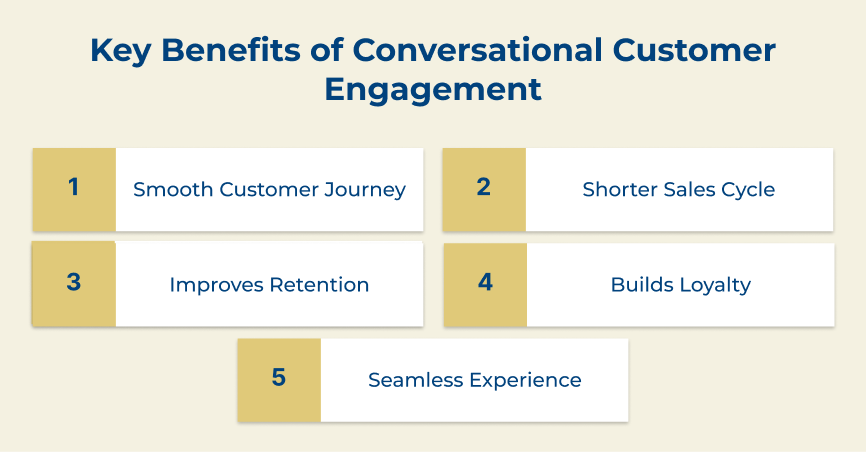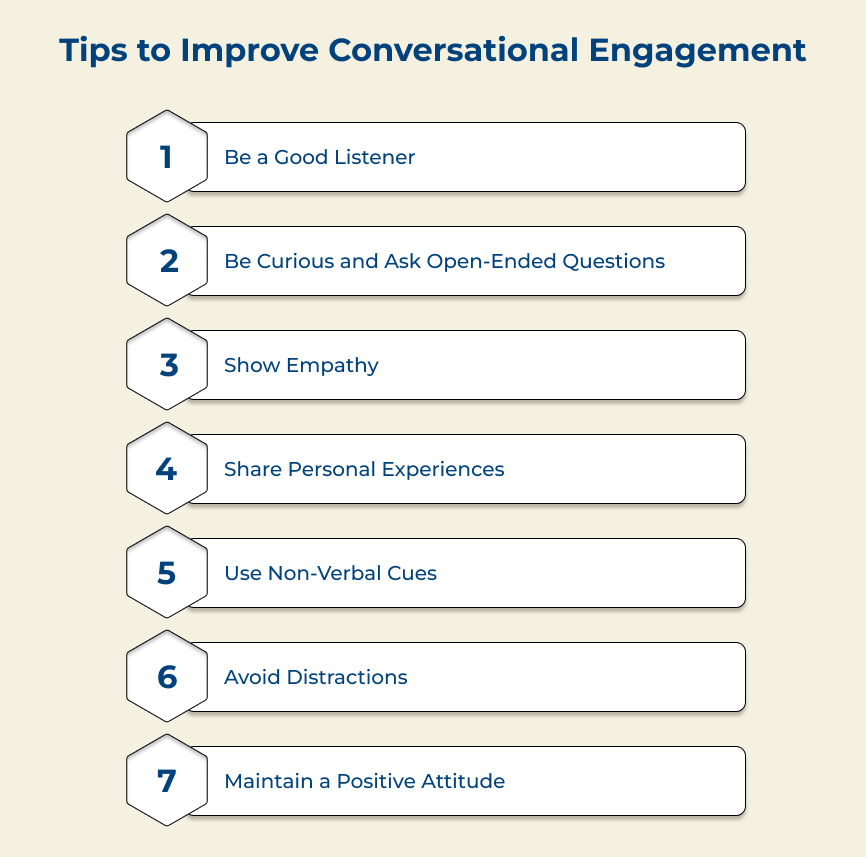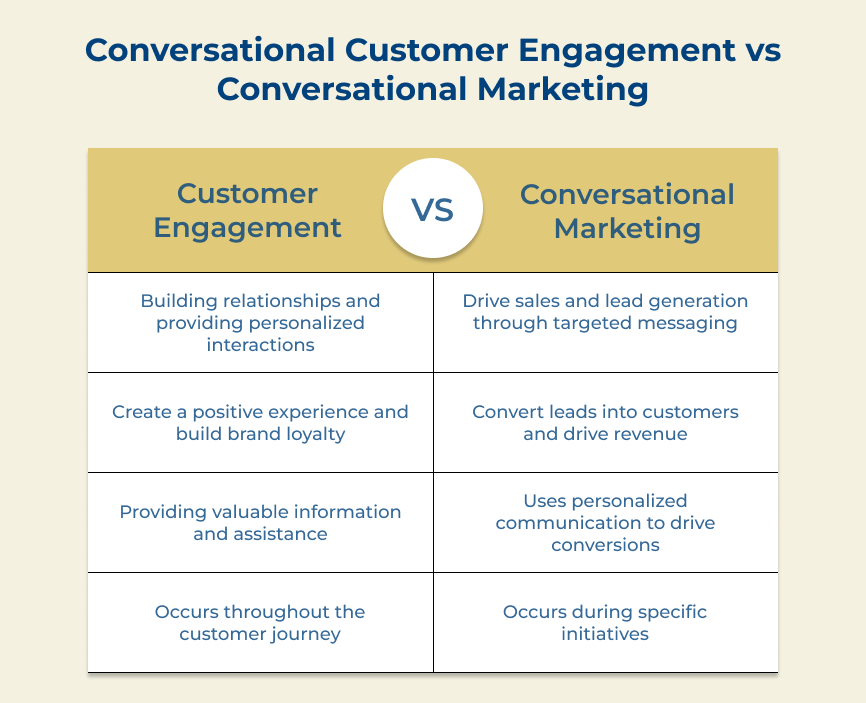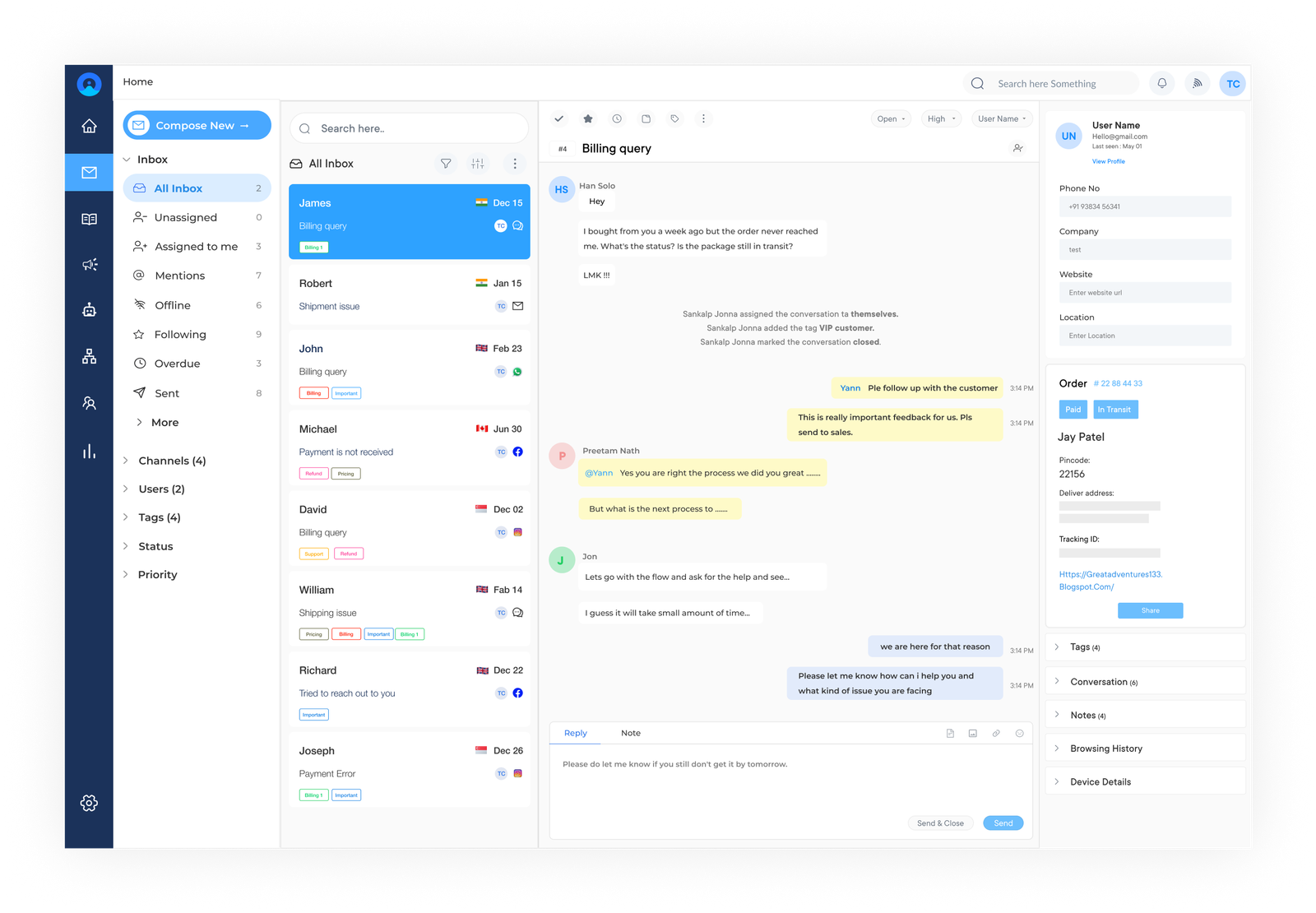1. Be a Good Listener
Being a good listener is an essential skill to have in any conversation, whether it’s with a colleague or customer. It demonstrates respect, empathy and a genuine interest in the other person. When you are a good listener, it significantly enhances your communication skills and builds stronger connections with your customers.
Actively listening to your customers shows them that their opinions, concerns and needs are valued. It creates a positive engaging experience and facilitates customer loyalty. Being a good listener is very important to improve your conversational engagement skills and create meaningful connections with customers.
Ways to implement:
- Practice active listening: Focus on the speaker, maintain eye contact and avoid distractions. Show that you are engaged by nodding, using verbal cues and asking relevant questions.
- Show empathy: Put yourself in the customer’s shoes and try to understand their perspective. Acknowledge their feelings and validate their concerns. Empathy builds trust and rapport, leading to more fruitful conversations.
- Take notes and follow up: Jotting down important points during the conversation shows that you value the customer’s input. Use the notes to follow up on any unresolved issues or to provide personalized recommendations later.
2. Be Curious and Ask Open-Ended Questions
Conversations are an essential part of every business, whether they occur in a personal or professional setting. Engaging in meaningful conversations can facilitate better connections, gain valuable information and enhance relationships. One powerful tip to improve conversational engagement is to be curious and ask open-ended questions.
Being curious and asking open-ended questions allows businesses to delve deeper into a conversation. It encourages the other user to share more and facilitates a more engaging dialogue. The approach shows genuine interest from the business end, making the user feel valued and listened to.
Ways to implement:
- Avoid closed-ended questions: Instead of asking questions that can be answered with a simple “yes” or “no,” ask open-ended questions that invite discussion and elaboration.
- Show curiosity and active listening: Demonstrate a genuine curiosity by actively engaging in the conversation. Maintain eye contact, nod and provide verbal cues such as to show attentiveness.
- Follow up with probing questions: Once the conversation is flowing, don’t hesitate to ask follow-up questions that delve deeper into the topic. It shows that you are actively listening and interested in gaining a more comprehensive understanding.
3. Show Empathy
Empathy is the ability to understand and share the feelings of others. It allows us to connect on a deeper level, create trust and build strong relationships. Empathy improves conversational engagement by making the other person feel heard and understood. When someone feels understood, they are more likely to open up and engage in a genuine conversation. It creates an atmosphere of trust and builds rapport, leading to more satisfying interactions.
Imagine you are talking to a colleague who recently lost a loved one. Instead of offering generic condolences, showing empathy would involve truly listening and responding with compassion. You can say, “I can’t imagine the pain you’re going through, but I’m here for you if you need anything.” The empathetic response acknowledges their feelings and offers support, promoting a deeper connection.
Ways to implement:
- Practice active listening: Pay attention to the speaker to provide verbal and non-verbal cues to show you are engaged. Show genuine interest in their thoughts and feelings.
- Validate emotions: Empathize with the person’s emotions, even if you haven’t personally experienced a similar situation. Acknowledge their feelings without judgment and let them know you understand how they might be feeling.
- Offer support: Show your willingness to help by asking how you can assist or simply being there to listen. Let the person know they can rely on you for support, creating a sense of comfort.
4. Share Personal Experiences
Sharing personal anecdotes helps to create a connection with the audience and make the conversation more relatable. It not only enhances the level of trust but also adds depth to the conversation, making it more interesting and memorable. Sharing personal experiences improves conversational engagement by promoting a sense of authenticity and vulnerability.
Businesses can connect on a deeper level with their audience, as they can relate to the experiences and feel a sense of empathy. The connection brings about a genuine conversation that goes beyond the surface level, making it more meaningful and engaging for everyone involved. Let’s say you’re discussing a certain topic or product. Do share a personal experience of how it has impacted your life.
Ways to implement:
- Active listening: Start by actively listening to others and finding opportunities to interject with a relevant personal experience.
- Be genuine and transparent in sharing your experiences: Authenticity is key to building trust and creating engaging conversations.
- Use your personal experiences as a tool for storytelling: Craft your story in a way that is relatable and resonates with your audience, creating an engaging conversation.
5. Use Non-Verbal Cues
Effective communication involves not only the words we use but also the non-verbal cues we give. Non-verbal cues play a crucial role in conveying our emotions, intentions, and attitudes during conversations. Paying attention to and utilizing such cues effectively allows businesses to significantly improve their conversational engagement.
Using non-verbal cues enhances the overall understanding and clarity of the message. Nodding the head in agreement or maintaining eye contact can show active listening and interest, making the other person feel valued. It helps establish rapport and trust, creating a comfortable environment for meaningful discussions.
Ways to implement:
- Maintain eye contact: Look directly at the person you’re conversing with to show attentiveness and interest. Avoid distractions and give them your full attention.
- Use facial expressions and gestures: Smile, raise your eyebrows or nod appropriately to encourage the speaker to continue sharing. Use hand gestures sparingly and appropriately to emphasize key points.
- Pay attention to body language: Maintain an open and relaxed posture, facing the person directly. Leaning in slightly can convey interest and engagement.
6. Avoid Distractions
When it comes to engaging in meaningful conversations, distractions can be a major hindrance. Whether it’s a ringing phone, a buzzing notification or simply a wandering mind, the distractions can pull us away from truly being present in a conversation. Consciously avoiding distraction allows businesses to significantly improve conversational engagement and make the most out of the interactions.
Individuals can give undivided attention to the person they’re conversing with, making them feel heard. Eliminating distractions ensures actively listening, understanding and responding effectively, leading to more fruitful discussions. Imagine you’re having a conversation with a colleague who is sharing their struggles. As they pour their heart out, you receive a text message. Make sure not to lose focus and continue listening to the colleague only.
Ways to implement:
- Create a distraction-free environment: Find a quiet space where you won’t be interrupted by external noises or devices. Put the phone on silent or in another room and ensure you have minimal visual distractions.
- Practice mindfulness: Before engaging in a conversation, take a moment to center yourself and let go of any racing thoughts or worries. It will help you be fully present for the conversation and avoid being mentally distracted.
- Show verbal and Non-verbal signs of engagement: Use active listening techniques such as nodding, maintaining eye contact and asking relevant questions. The cues indicate that you are fully engaged in the conversation and encourage the speaker to continue sharing.
7. Maintain a Positive Attitude
A positive attitude enhances conversational engagement by promoting trust and building rapport. It encourages open and honest communication, making people feel comfortable to express their thoughts. It leads to more meaningful conversations and increased participation from all parties involved.
Let’s take a business meeting for example. Maintaining a positive attitude can motivate team members to share their opinions and contribute actively to discussions. It promotes a collaborative environment and ensures everyone’s voices are heard, resulting in better decision-making.
Ways to implement:
- Begin with a smile: A simple smile can set the tone for a positive conversation and make others feel welcomed.
- Use positive language: Avoid negative or judgmental comments and focus on using positive, uplifting language. It encourages a more constructive and optimistic conversation.
- Show appreciation: Express gratitude and appreciation towards others during the conversation. Recognizing their contributions and accomplishments helps maintain a respectful atmosphere.
Conversational Customer Engagement vs Conversational Marketing
Explore the key differences between conversational customer engagement and conversational marketing, providing insights on how to leverage both strategies for a more impactful relationship with your customers.

















